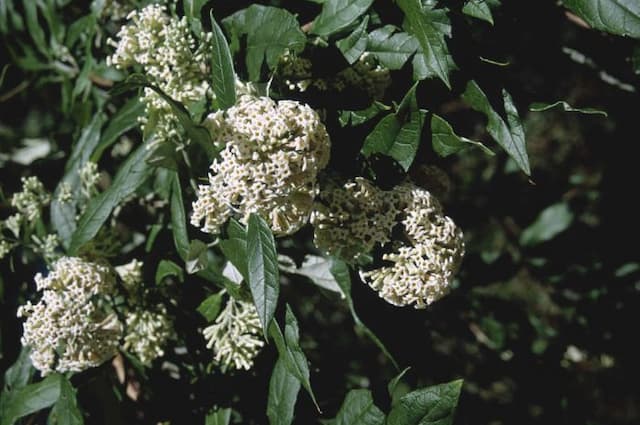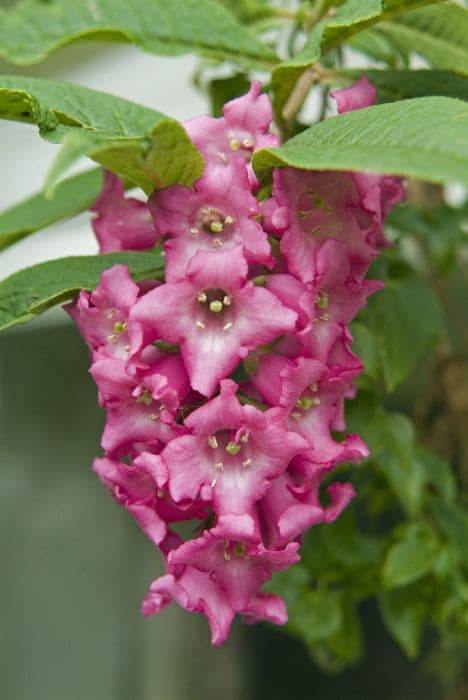Nemesia Nemesia Framboise = 'Fleurfram' (PBR)
![aloha [Framboise]](/_next/image?url=https%3A%2F%2Fplants-admin.emdemapps.com%2Fimages%2Fplants%2F%2Fimages%2F604b55cc7fbde.png&w=3840&q=75)
ABOUT
The Nemesia Framboise, known as 'Fleurfram', is distinguished by its vibrant and attractive flowers. Its blossoms exhibit a striking blend of colors, primarily a rich, raspberry pink that often blends into a softer, peach or coral pink towards the edges. The flowers typically have a velvety texture and may display subtle yellow or white accents that add to their depth and complexity. Duo-toned effect in the blooms creates a mesmerizing visual impact. These blooms cluster together, creating a lush, full look for the plant, and often have a delicate, slightly ruffled appearance that adds to their charm. The Nemesia Framboise showcases a bushy and compact shape, with its stems covered in small, narrow leaves that are generally a deep green color, providing a contrasting backdrop that makes the flowers truly stand out. The appearance of the Nemesia Framboise is further characterized by its extended blooming period, which allows for prolonged enjoyment of its colorful display. The combination of its unique flower colors and long-lasting bloom makes it a favorite choice for gardeners who wish to add a splash of color to their outdoor spaces or containers.
About this plant
 Names
NamesFamily
Scrophulariaceae
Synonyms
Cape Jewels, Nemesia
Common names
Nemesia Framboise 'Fleurfram' (PBR).
 Toxicity
ToxicityTo humans
Nemesia is not generally known for its toxicity to humans. There is limited information available on the toxicity of Nemesia plants, which suggests they are not commonly associated with severe poisoning if ingested. When dealing with ornamental plants like Nemesia, it is always best to err on the side of caution and avoid ingesting any part of the plant, as individual reactions can vary and some plants may cause mild stomach upset or irritation of the mouth and digestive tract if consumed.
To pets
Nemesia is generally considered non-toxic to pets. There is no well-documented evidence of Nemesia causing severe poisoning in animals. As with many plants not specifically known for toxicity, mild gastrointestinal upset is possible if pets consume significant quantities. However, it is always best to prevent pets from ingesting plants since individual reactions can vary, and there could be a risk of choking or more severe issues with certain plants or specific parts of a plant.
 Characteristics
CharacteristicsLife cycle
Annuals
Foliage type
Evergreen
Color of leaves
Green
Flower color
Pink
Height
1 foot (30 cm)
Spread
1 foot (30 cm)
Plant type
Herb
Hardiness zones
9
Native area
South Africa
Benefits
 General Benefits
General Benefits- Attractive Blooms: Nemesia flaunts vibrant raspberry-colored flowers that add a splash of color to gardens and landscapes.
- Extended Flowering Period: This variety has a long blooming season, providing visual interest from late spring to early autumn.
- Compact Size: Suitable for small gardens, containers, and hanging baskets due to its compact growth habit.
- Easy to Care For: It is relatively low-maintenance, only requiring basic gardening practices such as regular watering and occasional deadheading.
- Fragrance: The plant emits a light, pleasing scent that can enhance the sensory experience of a garden.
- Attracts Pollinators: Nemesia is known for attracting bees and butterflies, which are beneficial for pollination and the health of the garden ecosystem.
- Versatility: It can be used in a variety of garden designs, including borders, mixed containers, and as accent plants.
- Drought Tolerance: Once established, it has a certain degree of drought tolerance, making it suitable for gardens in drier climates.
- Frost Resistance: Nemesia can tolerate light frosts, which means it can survive in slightly cooler climates than other more tender plants.
 Medical Properties
Medical PropertiesThis plant is not used for medical purposes.
 Air-purifying Qualities
Air-purifying QualitiesThis plant is not specifically known for air purifying qualities.
 Other Uses
Other Uses- Nemesia as a natural dye: The vibrant flowers can be used to produce a natural dye for fabrics, bringing a hint of pink or raspberry hue to textiles.
- Garden photography: Due to its striking colors, Nemesia is an excellent subject for garden photography, helping photographers to practice macro photography techniques.
- Edible garnish: Although not commonly known as an edible plant, Nemesia's flowers can be used as a delicate, colorful garnish for desserts and salads, as long as they haven't been treated with any chemicals.
- Crafting pressed flowers: Craft enthusiasts may use the flowers of Nemesia for making pressed flower arrangements due to their flat shape and vibrant colors.
- Homemade potpourri: Dried Nemesia flowers can contribute to a homemade potpourri mix, adding a subtle fragrance and colorful touch to a room.
- Floral art: Artists and hobbyists may use Nemesia flowers in botanical art and mixed media projects for their unique appearance and texture.
- Sensory gardens: The unique fragrance of Nemesia makes it an ideal plant for sensory gardens, which aim to provide a therapeutic experience.
- Teaching tool: Nemesia can be used in educational settings to teach children about plant growth, flowering, and the pollination process.
- Nature crafts for kids: The colorful flowers and leaves can be used in crafts with children, such as making bookmarks or decorating hats.
- Ephemeral jewelry: Crafters may use the fresh flowers of Nemesia to create temporary, biodegradable jewelry such as necklaces and bracelets.
Interesting Facts
 Feng Shui
Feng ShuiThe plant Nemesia is not used in Feng Shui practice.
 Zodiac Sign Compitability
Zodiac Sign CompitabilityThe plant Nemesia is not used in astrology practice.
 Plant Symbolism
Plant Symbolism- Friendship: Nemesia often symbolizes companionship and friendliness, making it a great gift to represent a strong bond.
- Positive Energy: The bright and cheerful colors of Nemesia can be symbolic of a positive outlook and joyful energy.
- Passion: The vibrant hues of this variety of Nemesia could be associated with passion and enthusiasm in life.
- Success: Some believe that Nemesia represents success and good fortune, making it symbolic of achieving one's goals.
 Water
WaterCape Jewels require regular watering to keep the soil consistently moist but not waterlogged. During the growing season, water the plant approximately once a week with about 16 ounces of water, but this may vary depending on climate conditions and soil type. It's crucial to check the top inch of soil for dryness before watering; if it's dry, it's time to water. Reduce watering frequency in the winter months when the plant is not actively growing.
 Light
LightCape Jewels thrive in a spot with full sun to partial shade. The best light conditions for this plant involve at least 6 hours of sunlight per day, as the sun encourages better blooms. However, too much direct afternoon sun can be harsh, so a location that provides some afternoon shade in extremely hot climates can be beneficial.
 Temperature
TemperatureCape Jewels prefer a mild climate and thrive best in temperatures ranging from 50°F to 75°F. They can withstand minimum temperatures down to around 30°F but should be protected from frost. For optimal growth, maintain an environment where the temperature does not frequently drop below 50°F or rise above 75°F.
 Pruning
PruningPruning Cape Jewels is essential to encourage bushier growth and more blooms. Deadhead spent flowers regularly to promote continuous blooming throughout the season. Lightly trim back the plant after the main flowering flush to rejuvenate and encourage a second burst of blooms. The best time for a more substantial pruning is in late winter or early spring, just before new growth begins.
 Cleaning
CleaningAs needed
 Soil
SoilThe ideal soil mix for Nemesia Framboise should be light, well-draining, and rich in organic matter, with a slightly acidic to neutral pH range of 5.5 to 7.0.
 Repotting
RepottingNemesia Framboise typically requires repotting every year or when the plant outgrows its current container, to refresh the soil and encourage healthy growth.
 Humidity & Misting
Humidity & MistingNemesia Framboise prefers moderate to high humidity levels but is adaptable to a range of indoor humidity conditions.
 Suitable locations
Suitable locationsIndoor
Place in bright, indirect light and avoid temperature extremes.
Outdoor
Grow in well-drained soil; protect from harsh afternoon sun.
Hardiness zone
9-11 USDA
 Life cycle
Life cycleNemesia 'Fleurfram', commonly referred to as Nemesia, begins its life cycle when seeds are sown in the soil, typically in the early spring or after the danger of frost has passed. Seedlings emerge from the soil and, given proper sunlight and water, will soon develop true leaves, signaling the start of the vegetative growth phase. During the vegetative phase, the plant develops its root system and foliage, growing rapidly in preparation for flowering. Flowering occurs in late spring to summer, showcasing vibrant blossoms that attract pollinators and allow for sexual reproduction. After pollination, the flowers will set seed, which can be collected if seeds are desired or left to self-sow if natural propagation is preferred. As temperatures cool or conditions become less favorable, Nemesia 'Fleurfram' may go dormant or die back, especially in colder climates, completing its annual life cycle.
 Propogation
PropogationPropogation time
Spring to early summer
Nemesia Framboise, commonly known as Nemesia, can be effectively propagated through the sowing of seeds. The ideal time for sowing seeds of Nemesia is in the late winter to early spring when the temperatures are mild, and frost is less likely to occur. To propagate by seeds, fill a tray with a well-draining seed starting mix and sprinkle the tiny seeds on top, pressing them lightly into the soil without covering them, as they require light to germinate. Keep the tray in a warm, bright place and maintain consistent moisture without saturating the soil. Germination usually occurs within 10 to 14 days. Once seedlings are large enough to handle and after the threat of frost has passed, they can be transplanted into individual pots or the garden. It's important to acclimate the plants gradually to outdoor conditions to prevent shock.

![Butterfly bush [Berries and Cream]](/_next/image?url=https%3A%2F%2Fplants-admin.emdemapps.com%2Fimages%2Fplants%2F%2Fimages%2F604b650f667be.png&w=640&q=75)





![Butterfly bush [Nanho Purple]](/_next/image?url=https%3A%2F%2Fplants-admin.emdemapps.com%2Fimages%2Fplants%2F%2Fimages%2F604b5e3cb2c58.png&w=640&q=75)
